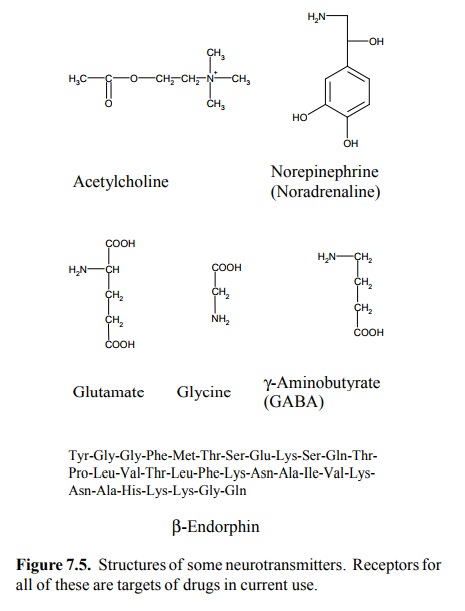Chapter: Biochemical Pharmacology : Drugs that act on sodium and potassium channels
Pharmacologically important neurotransmitters and their receptors
Pharmacologically important
neurotransmitters and their receptors
Some examples of important
neurotransmitters are shown in Figure 7.5. The first one to be recognized – and
still one of those most important for pharmacotherapy – is acetylcholine. Its
enzymatic cleavage by cholinesterase enables its extremely fast inactivation,
which is necessary in a synapse with very high repetition rates such as the
neuro-muscular junction in skeletal muscle. However, it is also used in slower
synapses in the peripheral autonomic nervous system, as well as in the central
nervous system;

we will see later that these
different types of cholinergic synapses may be targeted by specific drugs.
Norepinephrine occurs in the
peripheral and central au-tonomic system. The most important problem that is
ad-dressed by drugs acting on adrenergic synapses is high blood pressure. Many
of these drugs act as postsynap-tic antagonists or as presynaptic agonists,
respectively. Dopamine differs from norepinephrine only by lacking its single
aliphatic hydroxyl group. Parkinson's disease is due to a dopamine deficit
owing to the degeneration of a fairly tiny group of nerve cells in the
brainstem (called the `sub-stantia nigra', black substance). Application of
L-DOPA, the precursor of dopamine, is the mainstay of therapy.
While both dopamine and
norepinephrine are derived from tyrosine, serotonin (5-hydroxytryptamine, 5-HT)
is derived from tryptophan. All three transmitters are very important in
psychiatric disorders, and accordingly many psychophar-maca act on their
receptors.
Glutamate is the most
widespread transmitter in the cen-tral nervous system. Despite its widespread
occurrence, there are few clinically useful drugs that target glutamater-gic
synapses. In some places in the brain, there is an antag-onism between
dopaminergic and glutamatergic neurons. Accordingly, inhibitors of glutamate
receptors are used in addition to L-DOPA in the treatment of Parkinson's
dis-ease. An example is amantadine, which acts on the NMDA type glutamate
receptor (see next section).
GABA (γ-aminobutyric acid) is derived from glutamate by decarboxylation.
It occurs predominantly in inhibitory synapses in the central nervous system,
as does glycine. Tetanus toxin acts on glycinergic neurons in the spinal cord,
which exert inhibitory regulation on the α-motoneurons.
β-Endorphin is but one of an ever-increasing number of peptide neurotransmitters, and one of the rare cases in which there
actually are specific agonists and antagonists – the name endorphin stands for
`endogenous morphine'.
Morphine and other opioids
act on receptors for β-endor-phin and the related enkephalins. β-Endorphin was found earlier than the other peptide transmitters
because opi-oids were made available by nature; they could be used as probes to
find the receptors, which could then in turn be used to screen brain extracts
for substances that would dis-place opioids from their receptors.
Related Topics